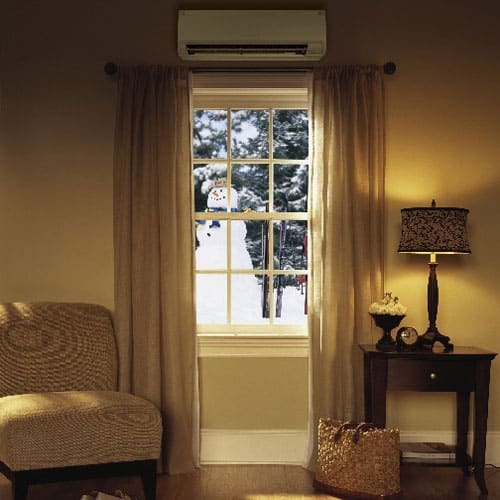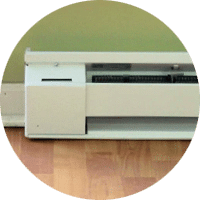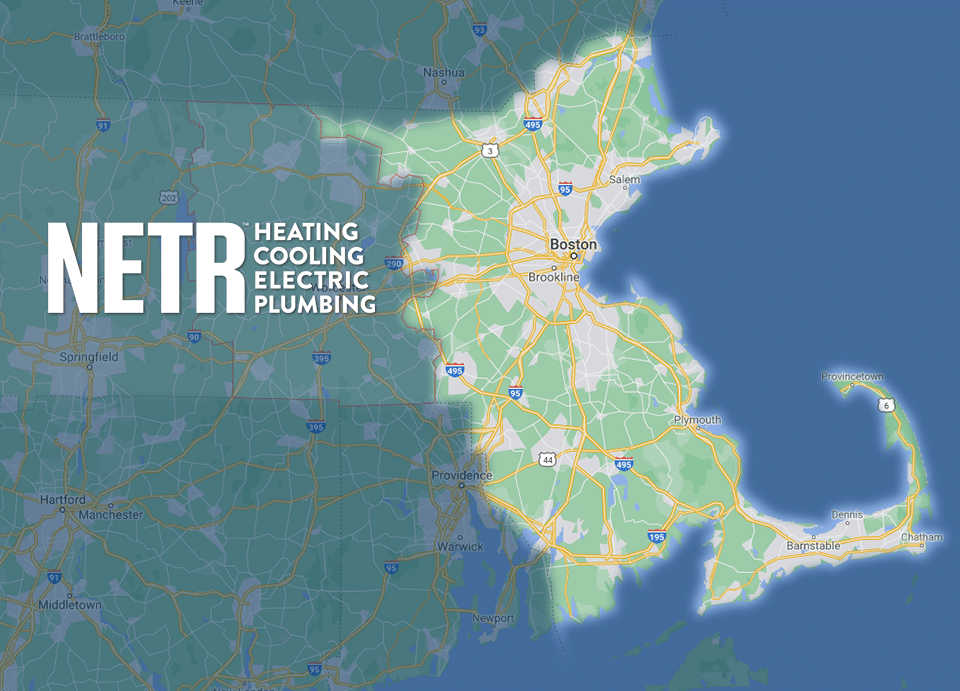HEAT WITH ELECTRIC?
SAVE BIG


Electric Baseboard Heat is Expensive!
“If electricity is the only choice, heat pumps are preferable in most climates, as they easily cut electricity use by 50% when compared with electric resistance heating.” — The U.S. Department of Energy
The exception is in the dryer climates of the western US, where heating days are far fewer than we have here in the Boston area.
Mitsubishi Electric has changed the heat pump game for New England homeowners with their Hyper Heat system, a heat pump that will keep your home warm in temperatures as low as 13 degrees below zero!

Are Your Electric Heating Bills Leaving You Hot and Bothered?
Are you using electric to heat your home?

Typical electric heating systems like baseboards, wall units, space heaters, or even radiant floor heating are very expensive to operate.

While they are efficient in turning energy into heat, the electricity used is generated mostly from traditional fuels at your local electric plant, that are only about 30% efficient at their job. Add in loss during transmission to your home, and you can begin to understand why electric heat tends to be more expensive than oil or gas when you heat your whole home.
Mitsubishi’s Hyper Heat Inverters can Turn Your Electric Bills Upside Down!

The new Mitsubishi H2i Hyper-Heating INVERTER™ heat pump also runs on electricity, but easily saves over 50% of the energy required by traditional electric heating methods to heat your home.
Double the Comfort In One Unit!

HEATING
Heat pumps move heat rather than worry about generating it, which is why they can use as little as 25% of the energy used by normal electric heating options. This efficiency helps move heat in the outside air into your home in the winter.

COOLING
It can reverse this process in warmer months, taking the heat inside your home and transfer it outside, providing great air conditioning, something no traditional electric heating system can do!


Why Give Up on Tradition? Choices, Comfort and Cost-Savings!
Baseboard Heat

Traditional baseboard electric heaters are installed on outside walls, often under windows, to counteract the cold air leaking into the home from the glass. They aren’t great at spreading heat throughout a room, so even with baseboard heating, it can take a while to make a room feel comfortable.
Wall-Mounted Heaters

Wall mounted electric heaters that have fans do a better job at distributing hot air, but they can’t be mounted on outside walls because of insulation issues.
Radiant Floor Heat

Radiant heating is trapped in the floor and likewise takes a while to provide adequate heating throughout the living space. It can be difficult to repair if a problem occurs, requiring dismantling of your floor- particularly painful if it is sunk in concrete or under tile!
Compare Ductless…
Ductless units, by comparison, can be mounted in a variety of places, and each unit can be controlled separately, offering separate zones of heating and cooling comfort wherever they are located.

By allowing you to heat or cool separate areas of your home independently, ductless can save you money both in Winter’s chill and Summer’s heat, no matter where you think they’ll work best in your home.

DO WE WORK IN YOUR TOWN?
We’ve installed ductless heating and air conditioning systems throughout the greater Boston area. See if we have an installation example in your neighborhood.

Ductless helps control air quality- Keep Your Family Healthier Year ‘Round!

A typical electric baseboard heating system is controlled by a wall-mounted thermostat, either through central control for the whole home, or for an individual room. It’s often hard to make the room perfectly comfortable, because the air is not evenly distributed throughout the space, and electric heaters do little to help with humidity control.
With ductless, both heat and humidity are controlled, so you’ll never have the same worries about dry skin, nasal passages that are more vulnerable to colds in the Winter, or cracks developing in your wooden furniture. Likewise even in peak of summer, ductless can remove excess moisture out of the air, making sure even damp prone basements stay comfortable and avoid that unpleasant musty smell. No need to add a humidifier or dehumidifier to your appliance list – ductless can help solve both problems in a way traditional electric heat just can’t.
HERE’S HOW IT WORKS
Ductless splits, also called “Mini-Splits” pump cooled or heated refrigerant directly to the wall or ceiling-mounted air-handling unit, and each unit has its own wireless electronic temperature control system, a.k.a., a remote.
Here’s how the system works in a single room application
- The indoor unit uses refrigerant to cool (or heat) air and quietly pushes the chilled air to where you need it in your living space.
- Refrigerant and electrical lines connect the outdoor unit to the indoor unit through a 3″ opening in the exterior wall.
- The outdoor unit’s state-of-the-art heat pump cools or warms refrigerant and sends it back inside to the air handler, which continuously monitors the room for changes in temperature and sends conditioned air to the areas of the room that need it, balancing the temperature throughout the space.

HYPER HEAT IS ENERGY EFFICIENT AND ENVIRONMENTALLY FRIENDLY

REDUCES YEARLY ENERGY COSTS
Hyper Heat systems use green technologies and are much more efficient, so homeowners never have to sacrifice comfort over concerns about high-energy costs.
- INVERTER-driven technology results in substantial energy and utility savings for homeowners.
- Zone control for improved comfort and decreased energy usage.
- All MXZ H2i Systems are ENERGY STAR® rated.





